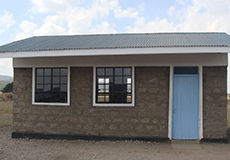NGOSUANI
The region of Ngosuani is located in the Narok County of Kenya. The community is predominantly composed of Maasai ethnic group.
WE Charity partnered with Ngosuani to implement community-led, holistic, and sustainable programming across the five-pillar development model to support new resources and expanded access to education, clean water, health care, food security, and economic opportunities.
Together, we have built sustainable mechanisms to support community growth as the people within the region of Ngosuani continue to drive their own transformational impacts.
The student population has increased since the partnership began, and overall student performance has improved. With this growth additional investments have been made in primary school infrastructure, including new buildings and renovations of classrooms and a school kitchen.
The following photos represent the 25 school rooms constructed or renovated by WE Charity in the region of Ngosuani. Each of the photos corresponds to a unique room including classroom or a school kitchen.
The following highlights reflect a small sample of the impacts from our partnership with the region of Ngosuani.
EDUCATION
-
Overall increase in student population since our partnership began
-
Improved teacher to student ratio
-
100% of enrolled primary school graduates transition to secondary schools
-
Improved academic performance, with a 13% increase in mean Kenya Certificate of Primary Education (KCPE) exam score since our partnership began
WATER
-
100% of community members will have access to clean water
-
Improved access to sanitation facilities for learners at school
-
Conducted community and school water and sanitation trainings to promote safe water purification practices and clean water harvesting techniques
-
Trained and empowered a water management committee to ensure the sustainability of clean water projects in the community


HEALTH
The 10 Habits of a Healthy Home program trains members of the community to implement basic health and sanitary indicators in their homesteads.
-
88% of all households have implemented 90% of the 10 Habits of a Health Home program indicators in their homes, decreasing conditions for preventable diseases
-
Community members have improved access to quality healthcare through Baraka Hospital, Kishon Health Centre, and mobile medical clinics
-
Conducted community trainings to encourage sustained safe health practices, which have realized a reduction in vaccine preventable diseases and maternal complications during pregnancy
FOOD
-
Supplemented school nutrition program
-
Access to large scale farm for provision of sustainably grown diverse foods and the opportunity to learn first-hand about new techniques and crops
-
Community members empowered to provide their families with a more diverse diet, improve food security for their families, and are equipped with modern farming skills and knowledge that will sustain them for years to come
ECONOMIC EMPOWERMENT
-
Over 100 community members have participated in an Economic Empowerment group, with nearly 300 total economic empowerment trainings completed
-
All participants have developed financial literacy skills, have become self-reliant, and over 95% of all participants have engaged in income generating activities aimed at improving their household incomes
WE CHARITY'S FIVE PILLAR DEVELOPMENT MODEL
WE Charity’s five-pillar development model empowers communities to break the cycle of poverty over, on average, a period of five to seven years of construction and local skill-capacity building, with a goal of long-term sustainability. Projects are focused on education, clean water, health care, food security and economic empowerment.
This holistic model starts with education, usually building schools or school rooms (including classrooms, libraries, kitchens, teachers’ accommodations, and school offices), that are then supported by other infrastructure needs key to breaking the cycle of poverty.
Building new schools or school rooms (or renovating existing structures where possible) are not the only inputs into the five-pillar development model. To date, WE Charity has built or renovated over 850 schools or school rooms in rural Kenya. Each school room is furnished with the necessary supplies, such as desks and chairs, libraries with books, and other essential items for teachers’ offices and accommodations. Funds are also allocated to critical program needs that ensure quality services are delivered. For example, teachers must be trained and housed, students need healthy meals, and health care facilities (training and supplies) are necessary to look after the health needs of both faculty and students.
This model and needs extend to all the pillars, such as training for those maintaining water projects; education of community and family leaders on agriculture and healthy food; recruitment, training, and housing of medical staff; and the cost of economically empowering the women of the communities to ensure the development model is financially self-sustainable.
Primary school rooms and regional high school rooms may include the following: a classroom, a library, teachers’ accommodations, an administrative office, a science lab, a student dormitory or a school kitchen, which are all key elements of our education programs. All educational infrastructure is designed for the best learning of students.
WE Charity’s records and finances have been reviewed annually by independent auditors, and WE Charity has undergone a special review for its international activities from a respected forensic auditor, confirming that WE Charity operates with the highest financial integrity.
The following photos each document a unique school or school room used for educational purposes which was constructed or renovated by WE Charity. Most of the buildings are stand-alone, while some school rooms are adjoining, in multi-room structures (where indicated).
Renovations (where indicated) may often include structural and foundation repairs, walling and floor rebuilding or repairs, roof rebuilding or repairs and the provision of important educational infrastructure including desks, chairs, and blackboards to ensure a conducive environment for children to learn. Learn more about renovations to education facilities, here.










Renovation

Renovation

Renovation

Renovation

Renovation

Renovation

Renovation

Part of a multi-room structure

Part of a multi-room structure

Part of a multi-room structure

Part of a multi-room structure






EXPLORE A MAP OF THE REGION

